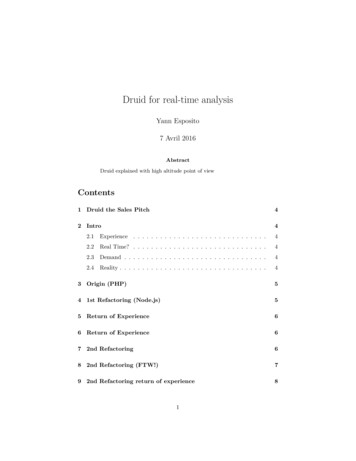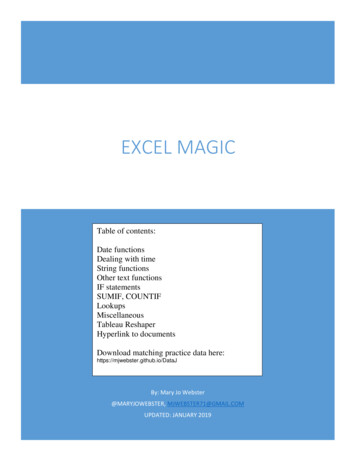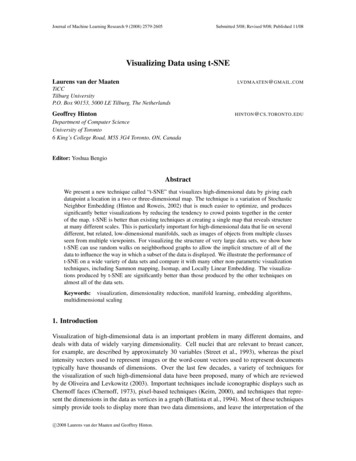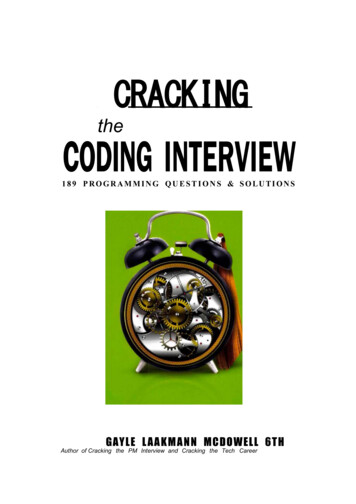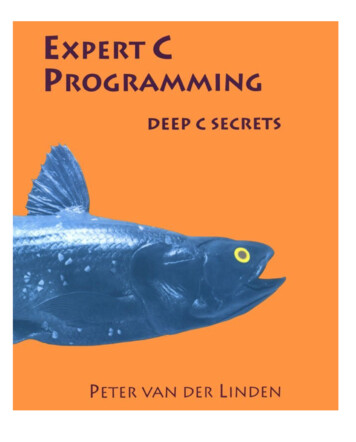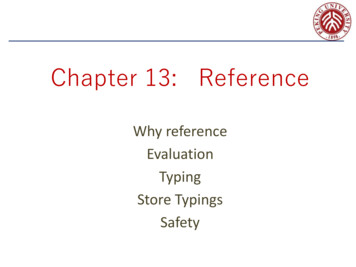
Transcription
Chapter 13: ReferenceWhy referenceEvaluationTypingStore TypingsSafety
References
Computational EffectsAlso known as side effects.A function or expression is said to have a side effect if,in addition to returning a value, it also modifies somestate or has an observable interaction with callingfunctions or the outside world.– modify a global variable or static variable, modify one ofits arguments,– raise an exception,– write data to a display or file, read data, or– call other side-effecting functions.In the presence of side effects, a program's behaviormay depend on history; i.e., the order of evaluationmatters.
Computational EffectsSide effects are the most common way that aprogram interacts with the outside world (people, filesystems, other computers on networks).The degree to which side effects are used depends onthe programming paradigm.– Imperative programming is known for its frequentutilization of side effects.– In functional programming, side effects are rarely used. Functional languages like Standard ML, Scheme and Scalado not restrict side effects, but it is customary forprogrammers to avoid them. The functional language Haskell expresses side effects suchas I/O and other stateful computations using monadicactions.
MutabilitySo far, what we have discussed does not yet include sideeffects .In particular, whenever we defined function, we neverchanged variables or data. Rather, we always computednew data.– E.g., the operations to insert an item into the data structuredidn't effect the old copy of the data structure. Instead, wealways built a new data structure with the item appropriatelyinserted.For the most part, programming in a functional style (i.e.,without side effects) is a "good thing" because it's easier toreason locally about the behavior of the program.
MutabilityWriting values into memory locations is thefundamental mechanism of imperative languagessuch as C/C .Mutable structures are– required to implement many efficient algorithms.– also very convenient to represent the current stateof a state machine.
MutabilityIn most programming languages, variablesmutable — i.e., a variable provides bothare– a name that refers to a previously calculated value, and– the possibility of overwriting this value with another (whichwill be referred to by the same name)In some languages (e.g., OCaml), these features areseparate:– variables are only for naming — the binding between avariable and its value is immutable– introduce a new class of mutable values (called referencecells or references) at any given moment, a reference holds a value (and canbe dereferenced to obtain this value) a new value may be assigned to a reference
Basic Examples#let r ref 5val r : int ref {contents 5}// The value of r is a reference to a cell that always contain a number.# r: !r 3# !r-: int 8(r: succ(!r); !r)
Basic Examples# let flag ref true;;-val flag: bool ref {contents true}# if !flag then 1 else 2;;-: int 1
ReferenceBasic operations– allocation– dereferencing !– assignmentref (operator): Is there any difference between the expressions of ?– 5 3;– r: 8;– (r: succ(!r); !r)– (r: succ(!r); (r: succ(!r); (r: succ(!r); !r)sequencing
ReferenceExercise 13.1.1 : Draw a similar diagram showing theeffects of evaluating the expressions a {ref 0, ref 0}and b (𝜆x:Ref Nat. {x,x}) (ref 0)
AliasingA value of type ref T is a pointer to a cell holding a value oftype Tr 5If this value is “copied” by assigning it to another variable:s r;the cell pointed to is not copied. ( r and s are aliases)r s 5So we can change r by assigning to s:(s: 10; !r)
Aliasing all around usReference cells are not the only language featurethat introduces the possibility of aliasing– arrays– communication channels– I/O devices (disks, etc.)
The difficulties of aliasingThe possibility of aliasing invalidates all sorts of useful formsof reasoning about programs, bothby programmers:e.g., function𝜆𝑟: 𝑅𝑒𝑓 𝑁𝑎𝑡. 𝜆𝑠: 𝑅𝑒𝑓 𝑁𝑎𝑡. (𝑟 2; 𝑠 3; ! 𝑟)always returns 2 unless 𝑟 and s are aliasesand by compilers:Code motion out of loops, common sub-expression elimination,allocation of variables to registers, and detection of uninitializedvariables all depend upon the compiler knowing which objects aload or a store operation could reference.High-performance compilers spend significant energy onalias analysis to try to establish when different variablescannot possibly refer to the same storage
The benefits of aliasingThe problems of aliasing have led some languagedesigners simply to disallow it (e.g., Haskell).However, there are good reasons why mostlanguages do provide constructs involving aliasing:––––efficiency (e.g., arrays)shared resources (e.g., locks) in concurrent systems“action at a distance” (e.g., symbol tables).
Example𝑐 𝑟𝑒𝑓 0incc 𝜆𝑥: 𝑈𝑛𝑖𝑡. (𝑐 𝑠𝑢𝑐𝑐 ! 𝑐 ; ! 𝑐)decc 𝜆𝑥: 𝑈𝑛𝑖𝑡. (𝑐 𝑝𝑟𝑒𝑑 ! 𝑐 ; ! 𝑐)incc 𝑢𝑛𝑖𝑡𝑑𝑒𝑐𝑐 𝑢𝑛𝑖𝑡o {i 𝑖𝑛𝑐𝑐, 𝑑 𝑑𝑒𝑐𝑐}𝑙𝑒𝑡 𝑛𝑒𝑤𝑐𝑜𝑢𝑛𝑡𝑒𝑟 o𝜆.𝑈𝑛𝑖𝑡 .let 𝑐 𝑟𝑒𝑓 0 inlet incc 𝜆𝑥: 𝑈𝑛𝑖𝑡. (𝑐 𝑠𝑢𝑐𝑐 ! 𝑐 ; ! 𝑐) inlet decc 𝜆𝑥: 𝑈𝑛𝑖𝑡. 𝑐 𝑝𝑟𝑒𝑑 ! 𝑐 ; ! 𝑐let o {𝑖 𝑖𝑛𝑐𝑐, 𝑑 𝑑𝑒𝑐𝑐} ino
Example
How to enrich the language with thenew mechanism ?
Syntax. plus other familiar types, in examples
Typing rulestype systema set of rules that assigns a property called type to the various“constructs “ of a computer program, such asvariables, expressions, functions or modules
EvaluationWhat is the value of the expression ref 0 ?Isr ref 0s ref 0andr ref 0s rbehave the same?Crucial observation: evaluating ref 0 must do something ?Specifically, evaluating ref 0 should allocate some storageand yield a reference (or pointer) to that storageSo what is a reference?
The storeA reference names a location in the store (also knownas the heap or just the memory)What is the store?– Concretely: an array of 8-bit bytes, indexed by 32/64-bitintegers More abstractly: an array of values, abstracting away fromthe different sizes of the runtime representations ofdifferent values Even more abstractly: a partial function from locations tovalues– set of store locations– Location : an abstract index into the store
LocationsSyntax of values:. and since all values are terms .
Syntax of Terms
AsideDoes this mean we are going to allow programmersto write explicit locations in their programs?No: This is just a modeling trick, just as intermediateresults of evaluationEnriching the “source language” to include some runtimestructures, we can thus continue to formalize evaluationas a relation between source termsAside: If we formalize evaluation in the big-step style,then we can add locations to the set of values(results of evaluation) without adding them to theset of terms
EvaluationThe result of evaluating a term now (with references)– depends on the store in which it is evaluated– is not just a value — we must also keep track of thechanges that get made to the storei.e., the evaluation relation should now map a termas well as a store to a reduced term and a new storet 𝜇 t ′ 𝜇′To use the metavariable 𝜇 to range over stores𝜇 & 𝜇′ : states of the store before & after evaluation
EvaluationA term of the form ref t11. first evaluates inside t1 until it becomes a value .2. then chooses (allocates) a fresh location 𝑙 ,augments the store with a binding from 𝑙 to v1 ,and returns 𝑙 :
EvaluationA term !t1 first evaluates in t1 until it becomes a value. and then1. looks up this value (which must be a location, if theoriginal term was well typed) and2. returns its contents in the current store
EvaluationAn assignment 𝑡1 𝑡2 first evaluates 𝑡1 and𝑡2 until they become values . and then returns unit and updates the store:
EvaluationEvaluation rules for function abstraction andapplication are augmented with stores, but don’tdo anything with them directly
AsideGarbage CollectionNote that we are not modeling garbage collection —the store just grows without boundIt may not be problematic for most theoreticalpurposes, whereas it is clear that for practical purposessome form of deallocation of unused storage must beprovidedPointer Arithmeticp ;We can’t do any!
Store Typing
Typing LocationsQuestion: What is the type of a location?Answer:Depends on the contents of the store!e.g,in the store (𝑙1 unit, 𝑙2 unit) , the term ! 𝑙2 isevaluated to unit, having type Unitin the store (𝑙1 unit, 𝑙2 λx: Unit. x), the term ! 𝑙2has type Unit Unit
Typing Locations — first tryRoughly, to find the type of a location 𝑙, first look up thecurrent contents of 𝑙 in the store, and calculate the type𝑇1 of the contents:More precisely, to make the type of a term depend on thestore (keeping a consistent state), we should change thetyping relation from three-place to :i.e., typing is now a four-place relation (about contexts,stores, terms, and types), though the store is a part of thecontext
Problems #1However, this rule is not completely satisfactory,and is rather inefficient.– it can make typing derivations very large (if a locationappears many times in a term) !– e.g.,𝜇 (𝑙1 λx: Nat. 999,𝑙2 λx: Nat. (! 𝑙1 ) x,𝑙3 λx: Nat. (! 𝑙2 ) x,𝑙4 λx: Nat. (! 𝑙3 ) x,𝑙5 λx: Nat. (! 𝑙4 ) x),then how big is the typing derivation for ! 𝑙5 ?
Problems #2But wait. it gets worse if the store contains a cycle.Suppose𝜇 (𝑙1 λx: Nat. (! 𝑙2 ) x,𝑙2 λx: Nat. (! 𝑙1 ) x)) ,how big is the typing derivation for ! 𝑙2 ?Calculating a type for 𝑙2 requires finding the type of 𝑙1 ,which in turn involves 𝑙2
Why?What leads to the problems?Our typing rule for locations requires us torecalculate the type of a location every time it’smentioned in a term, which should not benecessaryIn fact, once a location is first created, the type ofthe initial value is known, and the type will be kepteven if the values can be changed
Store TypingObservation:The typing rules we have chosen for referencesguarantee that a given location in the store is alwaysused to hold values of the same typeThese intended types can be collected into a storetyping:— a partial function from locations to types
Store TypingE.g., for𝜇 (𝑙1 λx: Nat. 999,𝑙2 λx: Nat. (! 𝑙1 ) x,𝑙3 λx: Nat. (! 𝑙2 ) x,𝑙4 λx: Nat. (! 𝑙3 ) x,𝑙5 λx: Nat. (! 𝑙4 ) x ) ,A reasonable store typing would be
Store TypingNow, suppose we are given a store typingΣ describing the store 𝜇 in which we intend toevaluate some term tThen we can use Σ to look up the types of locationsin t instead of calculating them from the values in 𝜇i.e., typing is now a four-place relation on contexts, storetypings, terms, and types.Proviso: the typing rules accurately predict the results ofevaluation only if the concrete store used duringevaluation actually conforms to the store typing
Final typing rules
Store TypingWhere do these store typings come from?When we first typecheck a program, there will be noexplicit locations, so we can use an empty store typing,since the locations arise only in terms that are theintermediate results of evaluationSo, when a new location is created during evaluation,we can observe the type of v1 and extend the “currentstore typing” appropriately.
Store TypingAs evaluation proceeds and new locations arecreated, the store typing is extended by looking atthe type of the initial values being placed in newlyallocated cells only records the associationbetweenalready-allocated storage cellstheir typesand
SafetyCoherence between the statics and the dynamicsWell-formed programs are well-behavedwhen executed
Preservationthe steps of evaluationpreservetyping
PreservationHow to express the statement of preservation?First attempt: just add stores and store typings in theappropriate placesTheorem(?): if Γ Σ t: T and t 𝜇 t ′ 𝜇′ ,then Γ Σ t′: TRight?Wrong!Why wrong?Because Σ and 𝜇 here are not constrained to have anythingto do with each other!Exercise: Construct an example that breaks this statement ofpreservation
PreservationDefinition: A store 𝜇 is said to be well typed withrespect to a typing context Γ and a store typing Σ,written Γ Σ 𝜇, if 𝑑𝑜𝑚 𝜇 𝑑𝑜𝑚 Σ and Γ Σ 𝜇 𝑙 : Σ 𝑙 for every l 𝑑𝑜𝑚 𝜇Theorem (?) : ifΓ Σ t: Tt 𝜇 t ′ 𝜇′Γ Σ 𝜇then Γ Σ t′: TRight this time?Still wrong !Why? Where? (E-REFV)13.5.2
PreservationCreation of a new reference cell .𝑙 𝑑𝑜𝑚 𝜇ref v1 𝜇 𝑙 (𝜇, 𝑙 v1 )(E-REFV). breaks the correspondence between the store typingand the store.Since the store can grow during evaluation:Creation of a new reference cell yields a store with alarger domain than the initial one, making the conclusionincorrect: if 𝜇′ includes a binding for a fresh location 𝑙 ,then 𝑙 cann’t be in the domain of Σ , and it will not be thecase that 𝒕′ is typable under 𝜮
PreservationTheorem: ifΓ Σ t: TΓ Σ 𝜇t 𝜇 t ′ μ′then, for some Σ ′ Σ,Γ Σ′ t′: TΓ Σ′ 𝜇′.A correct version.What is Σ ′ ?Proof: Easy extension of the preservation proof for𝜆
Progresswell-typed expressions areeithervaluesor can be further evaluated
ProgressTheorem:Suppose t is a closed, well-typed term(i.e., Γ Σ t: T for some T and Σ)then either t is a value or else, for any store 𝜇 suchthat Γ Σ 𝜇, there is some term t′ and store 𝜇′witht 𝜇 t′ 𝜇′
Safety preservation and progress together constitute theproof of safety– progress theorem ensures that well-typed expressionsdon’t get stuck in an ill-defined state, and– preservation theorem ensures that if a step is a taken theresult remains well-typed (with the same type). These two parts ensure the statics and dynamicsare coherent, and that no ill-defined states can everbe encountered while evaluating a well-typedexpression
In summary
SyntaxWe added to λ (with Unit) syntactic forms forcreating, dereferencing, and assigning referencecells, plus a new type constructor Ref.
EvaluationEvaluation relation:t μ t′ μ′
TypingTyping becomes a four-place relation: Γ Σ t
of a state machine. Mutability In most programming languages, variables are mutable —i.e., a variable provides both –anamethat refers to a previously calculated value, and –the possibility of overwriting this value with another (which will be referred to by the same name) In some languages (e.g., OCaml), these features are separate: –variables are only for naming —the binding between .


